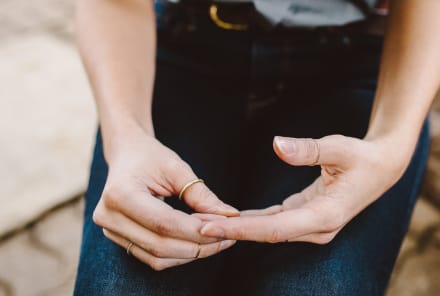Advertisement
Decoding Body Language: What Do Crossed Arms Actually Mean?


Flushed cheeks, raised eyebrows, eye contact: These nonverbal cues can reveal far more than words could convey. Though some forms of body language are subtle, it's easy to believe we've cracked the code of more obvious cues, like crossed arms. But have we, or are we more prone to misreading other people's body language than we realize?
Body language as a form of communication.
Verbal and nonverbal cues play relatively equal roles in communication, according to René Dailey, Ph.D., a communications professor at the University of Texas at Austin. However, the nonverbal can be more ambiguous because they don't have a specific grammar or semantic meaning, she explains.
"Body language is the way the body communicates and reacts to the environment around it as well as what is happening internally to a person," says David Stephens, a senior mentor at the Body Language Academy by Joe Navarro. "It can include everything that is expressed other than words such as facial expressions, different gestures, pacifying movements and vocal characteristics such as the tone and pitch of the voice."
Body language can help reveal a person's authentic emotions and reactions, as well as conscious or unconscious thoughts, says psychoanalyst Babita Spinelli, L.P. Because it can reveal unconscious thoughts, body language tends to "speak" first and, when words escape us, may even be the only form of communication.
"When we observe body language, we can pick up on signs about how someone is feeling or what they are not saying," Spinelli says. "It can also enhance our communication whether we are excited to share something—which is exemplified in facial expressions—or we are angry, by looking away, scowling, or pointing aggressively."
One common body language, which is often lumped into the angry or closed-off categories, is crossed arms. Though it can mean both of those things, sticking with those two interpretations is limiting.
What someone really means when their arms are crossed.
Crossed arms can have a variety of meanings. "For many, and this can often be the case, the perception is that arm crossing means we are feeling anxious, resistant, tense, insecure, afraid, or responding to distress," Spinelli says. Creating a physical boundary or barrier can also be an act of self-comfort when someone feels overwhelmed.
"If someone, however, has their arms crossed and is gripping each arm tightly, then this may be a sign of stress," Stephens adds.
According to Dailey, research has also linked arms crossing to defensiveness, unyielding attitudes, and perseverance. In fact, one study showed that people who crossed their arms before a task were more likely to work longer than those who didn't. Knowing that information, people who cross their arms may be attempting to focus or at least create an impression of power and control.
Because of the conflicting and varying interpretations of crossed arms, nonverbal behaviors usually require context to accurately understand. "For example, if the person we're talking to has their arms crossed but is smiling at us, leaning forward, and using friendly vocalics, then we likely don't interpret the arms crossed as showing negativity," Dailey says. "But if the arms crossed are paired with frowns, distancing, and a furrowed brow, then collectively we probably conclude they are not favorable toward us." Getting the full picture is helpful in preventing miscommunication.
How body language can lead to miscommunication.
Body language is one of the main ways we make sense of other people's motivations, intentions, and emotions, Stephens says. "We are always making assessments based on people's nonverbal communication. Often these quick assessments can be accurate; however, we can also get body language very wrong," he says.
Without the context of other nonverbal cues, arms crossed and other body language can be easily misinterpreted. "The possibility of miscommunication is especially increased if the nonverbals contradict what we say," Dailey says. You know: saying you're fine when you're most definitely not fine.
Without context, there's not always enough information to understand what someone is expressing or why they're feeling that way. This can make it hard to reach common ground or find a resolution in the face of conflict.
"The purpose of understanding context is significant to ensure you are picking up on the right signals," Spinelli says. "Furthermore, context is also relevant in relationships where body language elevates meaningful interactions in a positive manner, such as widening of the pupils to demonstrate love or leaning in to show interest."
These contexts and misunderstandings also play into a larger cultural context. "While one culture may see averted eyes as a sign of humility and respect, another may view it as rude or disrespectful," Spinelli explains. In these instances, verbal communication may be particularly important.
Common body language myths.
These are a few of the most common body language myths and what else they could mean, according to Spinelli:
- Myth: Mirroring someone else's body language is a form of mockery. Other possibility: They're empathizing or connecting with you.
- Myth: When someone covers their mouth or looks away, they're lying. Other possibility: They're covering their mouth out of surprise and looking away out of embarrassment.
- Myth: When someone looks into your eyes, they're being fully honest. On the other side, when someone averts eye contact, they're being deceptive. Other possibility: While direct eye contact is often associated with truth, master manipulators are often able to look directly into someone's eyes while lying.
"Body language must always be checked against the context and normal baseline of an individual before making an assessment," Stephens says. "That is, what is happening around you at the time and what is the normal behavior of an individual. Only once you take these factors into account can you really begin to accurately interpret a person's body language."
The bottom line.
Both verbal and nonverbal communication is critical for maintaining healthy relationships. But without assigning words to their feelings, it can be difficult to accurately understand what someone else is trying to convey. In the case of crossing your arms, while many might assume that arms crossed mean a person is angry or closed off, it can also mean they're feeling overwhelmed or even that they're just deeply focusing on a problem at hand.
While body language is a powerful way to express emotions, clearly these cues can be easily misinterpreted. To reduce the chance of unnecessary conflicts from miscommunication, pay attention to context and be open, honest, and willing to ask how the other person is feeling.
Watch Next
Enjoy some of our favorite clips from classes
Enjoy some of our favorite clips from classes
What Is Meditation?
Mindfulness/Spirituality | Light Watkins
Box Breathing
Mindfulness/Spirituality | Gwen Dittmar
What Breathwork Can Address
Mindfulness/Spirituality | Gwen Dittmar
The 8 Limbs of Yoga - What is Asana?
Yoga | Caley Alyssa
Two Standing Postures to Open Up Tight Hips
Yoga | Caley Alyssa
How Plants Can Optimize Athletic Performance
Nutrition | Rich Roll
What to Eat Before a Workout
Nutrition | Rich Roll
How Ayurveda Helps Us Navigate Modern Life
Nutrition | Sahara Rose
Messages About Love & Relationships
Love & Relationships | Esther Perel
Love Languages
Love & Relationships | Esther Perel

















